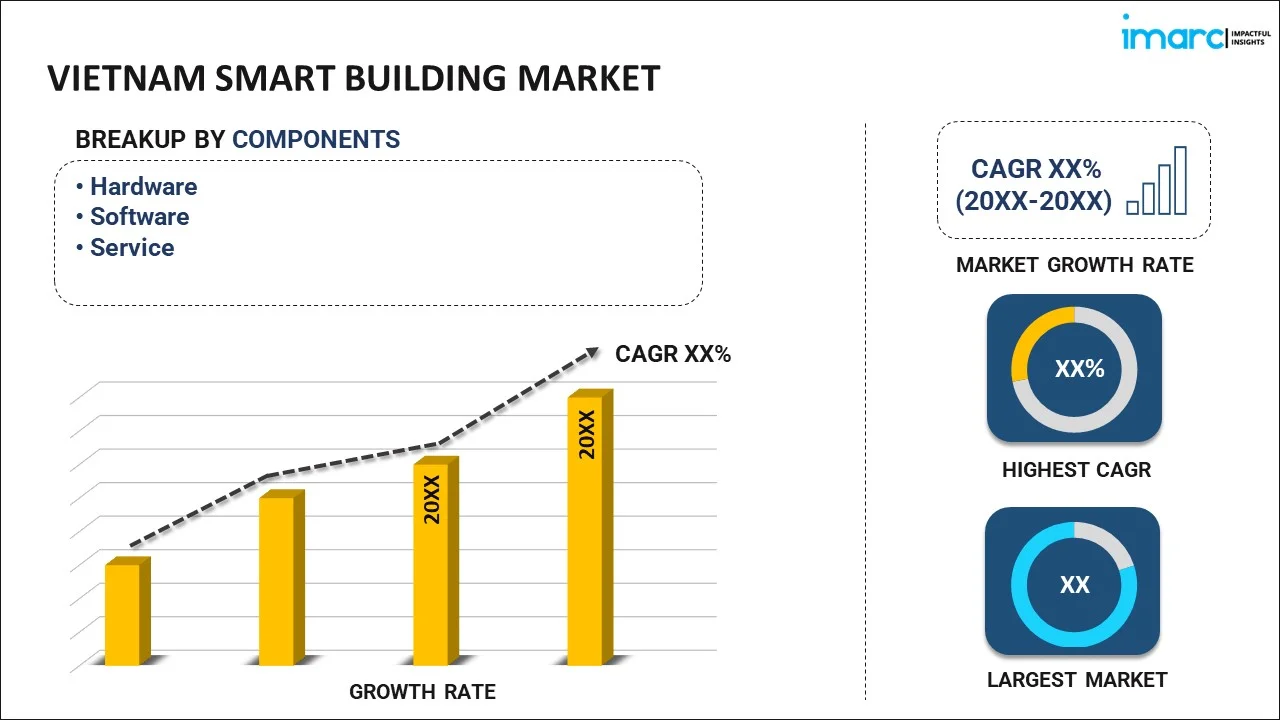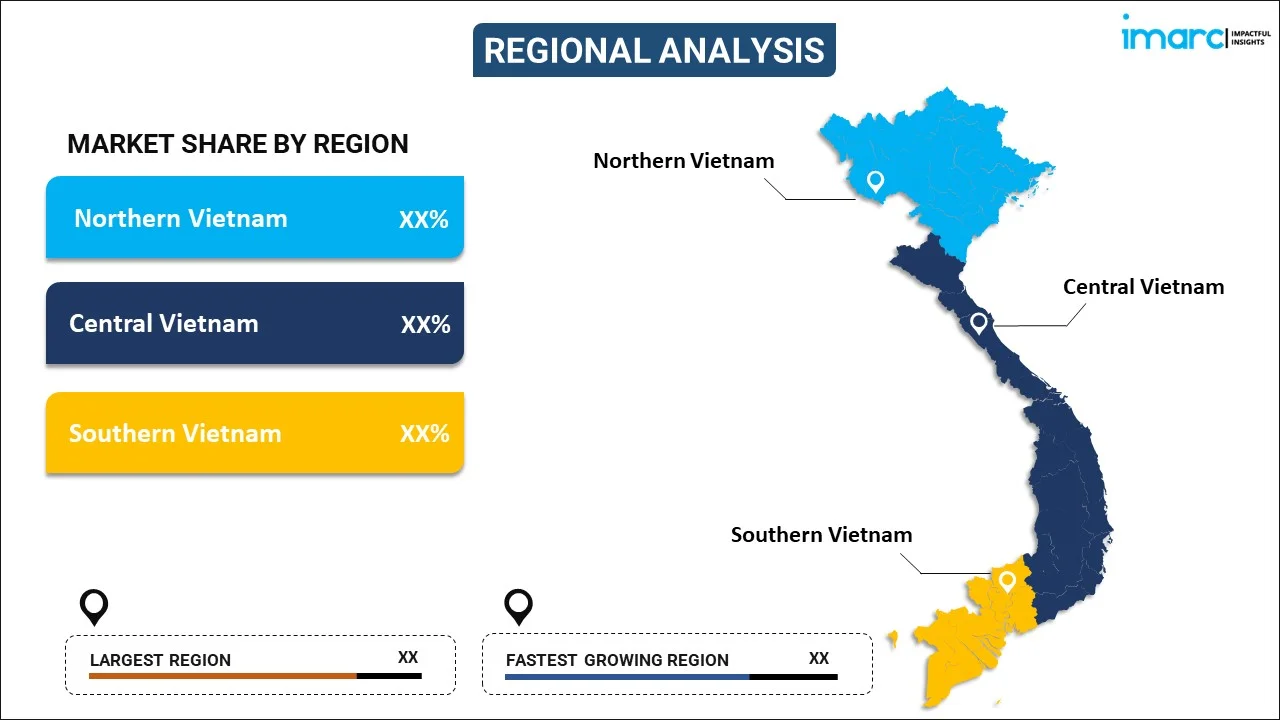
Vietnam Smart Building Market Report by Component (Hardware, Software, Service), Technology (Building Infrastructure Management (BIM), Security and Emergency Management, Energy Management, Network and Communication Management, Workforce Management, and Others), End User (Commercial, Residential, Government and Public Infrastructure, Healthcare, Education, Transport, Manufacturing and Industrial, and Others), and Region 2025-2033
Market Overview:
Vietnam smart building market size is projected to exhibit a growth rate (CAGR) of 15.6% during 2025-2033. The market is being propelled by several significant factors, including the rising requirement of energy-efficient buildings, an increasing desire for sustainable infrastructure, and the widespread adoption of connected devices.
|
Report Attribute
|
Key Statistics
|
|---|---|
|
Base Year
|
2024 |
|
Forecast Years
|
2025-2033
|
|
Historical Years
|
2019-2024
|
| Market Growth Rate (2025-2033) | 15.6% |
Smart buildings represent a new era of intelligent structures that incorporate advanced technology to optimize their functioning, enhance energy efficiency, and elevate the overall experience of occupants. They typically consist of various components, including sensors, control systems, and software applications that collaborate to collect and analyze data from diverse sources. These systems can monitor multiple parameters, such as temperature, humidity, lighting, occupancy, and energy consumption, in order to optimize the building's operations. A significant advantage of smart buildings lies in their ability to achieve energy efficiency. Through continuous monitoring and precise control of energy consumption, smart buildings can effectively curtail energy wastage, reduce utility expenses, and contribute to lower carbon emissions. Furthermore, they can enhance the comfort and productivity of occupants by providing superior lighting, temperature regulation, and air quality. Smart buildings come in various categories, including commercial, residential, and public structures like hospitals, schools, and government complexes, each tailored to meet specific needs and requirements.
Vietnam Smart Building Market Trends:
The Vietnam smart building market is currently witnessing substantial growth driven by several key factors, including the growing necessity for energy-efficient buildings and the increasing demand for sustainable infrastructure. Furthermore, the rapid expansion of the Internet of Things (IoT) and the widespread adoption of connected devices are significant catalysts for market expansion. This is further reinforced by the rising demand for advanced security and safety features within buildings. Additionally, the ongoing trend of urbanization and the pressing need for efficient infrastructure in developing nations contribute positively to the market's prospects in Vietnam. Furthermore, the increasing demand for intelligent lighting and heating, ventilation, and air conditioning (HVAC) systems, coupled with the integration of artificial intelligence (AI) and machine learning (ML) into building automation systems, are providing a strong impetus to market expansion. Other factors, such as the growing popularity of cloud-based solutions and the adoption of big data analytics within smart building management, are anticipated to fuel the market growth over the forecasted period.
Vietnam Smart Building Market Segmentation:
IMARC Group provides an analysis of the key trends in each segment of the market, along with forecasts at the country level for 2025-2033. Our report has categorized the market based on component, technology, and end user.
Component Insights:

- Hardware
- Software
- Service
- Professional Service
- Managed Service
The report has provided a detailed breakup and analysis of the market based on the component. This includes hardware, software, and service (professional service and managed service).
Technology Insights:
- Building Infrastructure Management (BIM)
- Parking Management System
- Smart Water Management System
- Elevators and Escalators Management System
- Security and Emergency Management
- Access Control System
- Video Surveillance System
- Safety System
- Energy Management
- HVAC Control System
- Lighting System
- Network and Communication Management
- Workforce Management
- Others
A detailed breakup and analysis of the market based on the technology have also been provided in the report. This includes building infrastructure management (BIM) (parking management system, smart water management system, and elevators and escalators management system), security and emergency management (access control system, video surveillance system, and safety system), energy management (HVAC control system and lighting system), network and communication management, workforce management, and others.
End User Insights:
- Commercial
- Residential
- Government and Public Infrastructure
- Healthcare
- Education
- Transport
- Manufacturing and Industrial
- Others
The report has provided a detailed breakup and analysis of the market based on the end user. This includes commercial, residential, government and public infrastructure, healthcare, education, transport, manufacturing and industrial, and others.
Regional Insights:

- Northern Vietnam
- Central Vietnam
- Southern Vietnam
The report has also provided a comprehensive analysis of all the major regional markets, which include Northern Vietnam, Central Vietnam, and Southern Vietnam.
Competitive Landscape:
The market research report has also provided a comprehensive analysis of the competitive landscape in the market. Competitive analysis such as market structure, key player positioning, top winning strategies, competitive dashboard, and company evaluation quadrant has been covered in the report. Also, detailed profiles of all major companies have been provided.
Vietnam Smart Building Market Report Coverage:
| Report Features | Details |
|---|---|
| Base Year of the Analysis | 2024 |
| Historical Period | 2019-2024 |
| Forecast Period | 2025-2033 |
| Units | Million USD |
| Scope of the Report | Exploration of Historical Trends and Market Outlook, Industry Catalysts and Challenges, Segment-Wise Historical and Future Market Assessment:
|
| Components Covered |
|
| Technologies Covered |
|
| End Users Covered | Commercial, Residential, Government and Public Infrastructure, Healthcare, Education, Transport, Manufacturing and Industrial, Others |
| Regions Covered | Northern Vietnam, Central Vietnam, Southern Vietnam |
| Customization Scope | 10% Free Customization |
| Post-Sale Analyst Support | 10-12 Weeks |
| Delivery Format | PDF and Excel through Email (We can also provide the editable version of the report in PPT/Word format on special request) |
Key Questions Answered in This Report:
- How has the Vietnam smart building market performed so far and how will it perform in the coming years?
- What has been the impact of COVID-19 on the Vietnam smart building market?
- What is the breakup of the Vietnam smart building market on the basis of component?
- What is the breakup of the Vietnam smart building market on the basis of technology?
- What is the breakup of the Vietnam smart building market on the basis of end user?
- What are the various stages in the value chain of the Vietnam smart building market?
- What are the key driving factors and challenges in the Vietnam smart building?
- What is the structure of the Vietnam smart building market and who are the key players?
- What is the degree of competition in the Vietnam smart building market?
Key Benefits for Stakeholders:
- IMARC’s industry report offers a comprehensive quantitative analysis of various market segments, historical and current market trends, market forecasts, and dynamics of the Vietnam smart building market from 2019-2033.
- The research report provides the latest information on the market drivers, challenges, and opportunities in the Vietnam smart building market.
- Porter's five forces analysis assist stakeholders in assessing the impact of new entrants, competitive rivalry, supplier power, buyer power, and the threat of substitution. It helps stakeholders to analyze the level of competition within the Vietnam smart building industry and its attractiveness.
- Competitive landscape allows stakeholders to understand their competitive environment and provides an insight into the current positions of key players in the market.
Need more help?
- Speak to our experienced analysts for insights on the current market scenarios.
- Include additional segments and countries to customize the report as per your requirement.
- Gain an unparalleled competitive advantage in your domain by understanding how to utilize the report and positively impacting your operations and revenue.
- For further assistance, please connect with our analysts.
 Inquire Before Buying
Inquire Before Buying
 Speak to an Analyst
Speak to an Analyst
 Request Brochure
Request Brochure
 Request Customization
Request Customization




.webp)




.webp)












